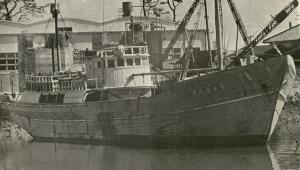
The Lucky Dragon. Image extracted from “The Voyage of the Lucky Dragon,” by Ralph E. Lapp.
Creative Nonfiction by Melinda Gormley and Melissae Fellet.
Bikini Atoll, March 1954.
On March 1, 1954, about three minutes after sunrise, a brilliant orange-colored flash lit up the sky. The sky glowed red and yellow.
“The sun is rising in a strange fashion. Hurry up and see it,” someone yelled.
Sanjiro Masuda suspected it was two to three minutes before the yellow faded. A dull red glow remained, “like a piece of iron cooling in the air,” he recalled. Then, he realized that the color could not be from the sun because it was rising in the west.
Five minutes later, a deafening sound of many thunders roared through the sky. The sailors saw a mushroom-shaped cloud and the sky darkened. “Pikadon,” which means atomic bomb, crossed Masuda’s mind, before he returned to his nets. There was work to be done.
A few hours later, white ash began raining down, covering the boat, the fishermen, and the water all around them. It fell for several hours.
Ash fell in Captain Tadaichi Tsutsui’s eyes, causing them to sting. He inhaled the ash, and the particles stayed in his nose even after blowing it several times. He felt warmer than usual, though he figured it was due to sunburn or windburn.
Bathing the white ash off was hard. The sailors scrubbed and scrubbed and scrubbed. Yet the ash stuck to their skin.
Captain Tsutsui’s concern for his crew grew as the day wore on. He ordered the steam trawler’s anchor pulled so they could begin the 2,000-mile voyage home.
The crew ate from the catch, although by the first night, few had an appetite. There was talk of pikadon, but few gave it serious consideration.
Still feeling hot three days later, the faces of some began to turn a dark gray.
Masuda’s face and hands started to swell and his body itched. The parts of his body that were exposed the day of the explosion suffered the most. He collected some of the ash into oilskin paper, intending to give it to someone for analysis when he got home.
Again someone suggested it was pikadon, but not all believed it true.
Some sailors complained of headaches and nausea. More experienced unbearable itching and terrible pain. Huge, irregular blisters started to appear on the skin of some. The men had washed their bodies, but not the gear. Their fishing nets and the boat’s ropes had also been covered with ash, and the men continued to touch it as they worked on the deck during the trip home.
Two weeks after the strange events had begun, the boat docked at Yaizu, about 120 miles southeast of Tokyo. Many of the fishermen were severely sick. All twenty-three went to the nearby Kyoritsu hospital. Dr. Toshisuke Oii prescribed a topical ointment for the burns and then called some experts at Tokyo University. The experts ordered the boat and its cargo quarantined, but not quickly enough.
The Lucky Dragon’s catch, about 16,500 pounds of tuna and shark, was distributed to Tokyo, Osaka, Nagoya, and elsewhere. Geiger counters supported what many feared: The boat was highly radioactive. Concerned that radioactive tuna and shark was for sale, health officials frantically hunted for it. Some was recovered. More than 4,000 pounds of suspect fish was buried in Tokyo; in Sapporo City, 14 tuna were buried after two were found to be contaminated.
But some of the catch had already sold. Six families in Sagamihara who had eaten raw tuna experienced stomachaches, numbness and diarrhea.
Eight other tuna boats in the Pacific Ocean along with the Lucky Dragon were also found to be radioactive. One fish merchant, expressing his worries about the impact this event would have on his business, also captured concerns about the global and long-term consequences of fallout. “This is just the catch from the Fortunate Dragon. What of all the rest of the fish in the sea? A tuna can travel 35 miles an hour.”
Masuda and his shipmate Tadashi Yamamoto had the worst burns. Both men were taken to Tokyo University Hospital. Doctors passed a Geiger counter over the top of Masuda’s head. It registered 6,500 counts. His head was shaved and the count reduced to 654. His pain was still tremendous. Pus oozed from his ears and eyes. His face was blackened and blistered. His hands resembled baseball mitts.
The ashes Masuda collected register 40,000 clicks per minute – 400 times higher than the planet’s largest naturally-occurring background radiation.
Japan was frenzied. Nine years had passed since the bombings at Hiroshima and Nagasaki. Pikadon had returned, and now the bombs had greater destructive power.
Details about the explosion that coated the Lucky Dragon in radioactive ash were revealed when the American press started covering the story 17 days after the blast. The United States had detonated a hydrogen bomb at Bikini Atoll, a remote collection of islands in the middle of the Pacific Ocean. The thermonuclear explosion was 750 times larger than the bomb detonated on Hiroshima, and its power surprised scientists.
The fishermen had been 71 miles from the detonation point and 14 miles outside the restricted area set by the US government. Their injuries were a sign that scientists had more to learn about how radiation spread following a nuclear explosion. The United States continued to test. In less than 60 days after the Bikini Atoll test, the US planned to detonate another bomb. This one would be four times more powerful than the previous weapon.
